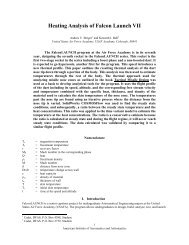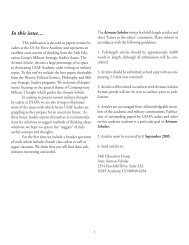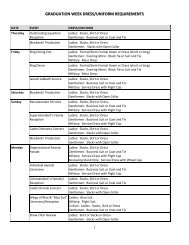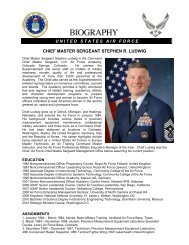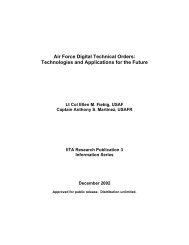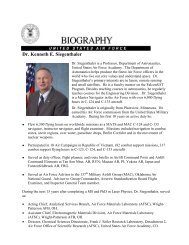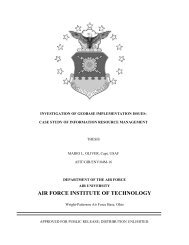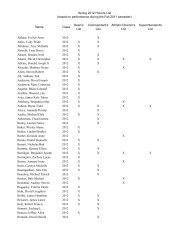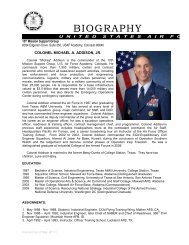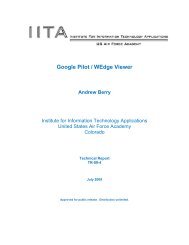the rollback of south africa's biological warfare program
the rollback of south africa's biological warfare program
the rollback of south africa's biological warfare program
Create successful ePaper yourself
Turn your PDF publications into a flip-book with our unique Google optimized e-Paper software.
nuclear weapons <strong>program</strong> and Project Coast. 127<br />
In contrast to <strong>the</strong> nuclear weapons <strong>program</strong>, no pressure was exerted in<br />
1989 or 1990 over <strong>the</strong> CBW <strong>program</strong>, even though <strong>the</strong> CIA released a report in<br />
1989 which placed South Africa on a list <strong>of</strong> countries that had developed and<br />
stockpiled chemical weapons. However, <strong>the</strong> main focus <strong>of</strong> concern for <strong>the</strong><br />
United States and her allies was nuclear proliferation. For a brief time,<br />
between 1987 and August 1990, when South Africa sold <strong>the</strong> G-6 155mm gun<br />
and chemical <strong>warfare</strong> agents, including NGT (CR) gas, to Iraq, <strong>the</strong> United<br />
States became concerned about <strong>the</strong> proliferation <strong>of</strong> a conventional weapon that<br />
had <strong>the</strong> capability to throw “exotic” shells. 128 However, <strong>the</strong>re was little or no<br />
interest among U.S. policy and intelligence communities about possible<br />
proliferation threats associated with South Africa’s <strong>biological</strong> <strong>warfare</strong><br />
<strong>program</strong>. The information that <strong>the</strong> CIA and MI-6 possessed was widely<br />
circulated or available within <strong>the</strong> Bush administration or <strong>the</strong> Thatcher/Major<br />
governments. This lack <strong>of</strong> interest changed in 1993, as <strong>the</strong> U.S. learned more<br />
about South Africa’s CBW and missile <strong>program</strong>s. Wouter Basson’s trips,<br />
particularly to Libya, and access to an informant, who provided <strong>the</strong> U.S. and<br />
allies with key details <strong>of</strong> Project Coast, increased <strong>the</strong> interest and concern <strong>of</strong><br />
<strong>the</strong> United States, Great Britain and o<strong>the</strong>r allies. The new information led <strong>the</strong><br />
U.S. and Britain to issue a demarche in April 1994. Israeli <strong>of</strong>ficials probably<br />
knew more about <strong>the</strong> <strong>program</strong> but did not want <strong>the</strong> U.S. and Britain to know<br />
that <strong>the</strong>y were involved with it.<br />
According to Gen. (ret.) Chris Thirion, 129 as <strong>the</strong> head <strong>of</strong> SADF<br />
intelligence, he was asked for access to Project Coast secrets by good friends<br />
overseas. These included pr<strong>of</strong>essional contacts in Germany, <strong>the</strong> U.S.,<br />
Switzerland, and Austria. Also, top South African authorities, Generals<br />
Liebenberg and Meiring asked him if he could put Basson in touch with <strong>the</strong><br />
right people. He refused to ask his U.S. counterparts, because he customarily<br />
met with <strong>the</strong>m collectively and thought it would be awkward to ask. In <strong>the</strong><br />
47




